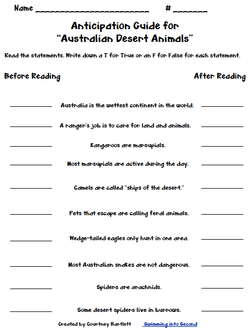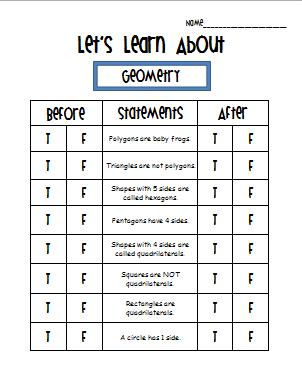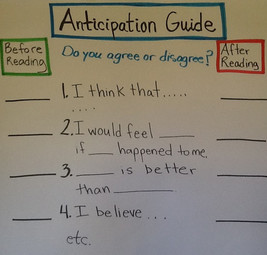Anticipation Guide
Definition/Description: An anticipation guide is used before reading to activate students' prior knowledge and get students excited and curious about a new topic. Before reading, students listen to the teacher or another student state key ideas about the concepts in the text. They can also read several statements about the key concepts presented in the text. The statements are usually put in a form where student say they agree or disagree (Reading Rockets, 2015).

Justification: "Teacher's can assist children in developing background knowledge by: Including techniques in lessons such as chapter previews or anticipation guides. As students begin to develop a conceptual framework for their own learning and understanding, they build a repertoire of background experiences from which to draw" (Echevarría, Vogt, and Short, 2013, pg.66). Teachers in the lesson are scaffolding and students are actively involved in discussion about each of the statements in the guide. When a teachers scaffolds for his/her students it provides them with the necessary skills and understanding to correctly complete, read, or do the lesson/activity. In this activity the teacher can model or scaffold the material at first, but remove when students start to understand (Wright, 2015). Piaget’s schema theory states activating prior knowledge before reading is essential, because according to his research when we can connect something “old” to something new it helps us better understand the new. As students are reading they are able to access their schema and make understand of the text and use their lived experiences. When students and teachers applied schema theory to reading comprehension readers constantly connect their background knowledge to the new knowledge in a text to help them make sense of the reading (Gunning, 2012). Anticipation guides are used to help students activate their prior knowledge to gain a better understanding of the topic. This strategy helps ELLs because they all have different backgrounds, but all of their experiences can be used to help better understand a new concept. According to our text when teachers assist students in developing their background knowledge and using their experience for learning new information it helps them gain a better understand of the content, because they are able to use what they already know (Echevarría, Vogt, and Short, 2013).
|
Purpose:
|
|
|
Differentiation for second language learners:
Examples of Sentence Starters to provide for ELL students or struggling learning:
|
Steps:
|
In this video a middle school science teacher explains how she uses an Anticipation Guide to help her students with vocabulary. This video demonstrates how this strategy can be used in other content areas besides just reading.
A suggestion made for teachers to help their English Language learners is to write the anticipation guide in the student’s primary language. "The point is to help students connect to what they will be reading in the target language so that they can better comprehend it, so the anticipation guide can be in any language that is well-comprehended by the student"(Every Language Learner, 2015).

Content Area Examples:
Reading:
Reading:
- For reading teachers choose a topic and content area. Then she/he creates a few statements and students determine if they think the statement is true or false. They then continue reading the text and after they are done they see if their predictions are correct. The topic can be on anything and that is why it can relate to any of the other content areas.
- For math there are different ways a teacher can use an anticipation guide. For example when students are learning about a new concept, ex: geometric figures, the teacher can have a set of statements. These statements can include equations, problems, or vocabulary. A teacher can use an anticipation guide to allow students to learn the vocabulary terms within a chapter. A teacher can also use one for word problems. (Take a look at the link below to see an example)
- For Science there are different ways a teacher can use an anticipation guide. One of the most common is to use them for a new unit in learning definitions, main ideas, concepts, and vocabulary. It can also be used during an experiment. For example It can be I think this will happen or I believe this might happen. It can be statements about the outcome, material, or safety rules.
- For Social Students, just like the example at the top about the dessert, an anticipation guide can be done for any topic. It can be vocabulary terms and the definitions. It can be examples or facts about the topic. The example above has statements about the environment, what might be there, etc. Students can learn more and have an idea about what they will be learning through these guides.
References:
Anticipation Guides (2012). [image of desert example]. Retrieved form http://www.swimmingintosecond.com/2012/02/anticipation-guides.html
Anticipation Guide (2015). Every Language Learner. Retrieved form http://www.everylanguagelearner.com/blogs/teaching-tips/tagged/anticipation-guide
Anticipation Guide (2015). Every Language Learner. [image]. Retrieved form http://www.everylanguagelearner.com/blogs/teaching-tips/tagged/anticipation-guide
Anticipation Guide (2015). Reading Rockets. Retrieved from http://www.readingrockets.org/strategies/anticipation_guide
Anticipation Guide (2012). Reading Rockets. [Web video]. Retrieved from https://www.youtube.com/watch?v=jQCKXQUquTc
Anticipation Guide (n.d). Teacher Toolkit [Web Video]. Retrieved formhttp://www.theteachertoolkit.com/index.php/tool/anticipation-guide
Echevarría, J., Vogt, M. E., & Short, D. (2013). Making content comprehensible for Elementary English language learners: The SIOP model. Boston, MA: Allyn & Bacon.
Gunning, T. G. (2012). Creating literacy instruction for all children in grades pre-K to 4. 2nd Edition. Boston: A and B.
Wright, W. E. (2015). Foundations for teaching English language learners: Research, theory, policy, and practice (2nd ed.). Philadelphia: Caslon Pub.
Anticipation Guides (2012). [image of desert example]. Retrieved form http://www.swimmingintosecond.com/2012/02/anticipation-guides.html
Anticipation Guide (2015). Every Language Learner. Retrieved form http://www.everylanguagelearner.com/blogs/teaching-tips/tagged/anticipation-guide
Anticipation Guide (2015). Every Language Learner. [image]. Retrieved form http://www.everylanguagelearner.com/blogs/teaching-tips/tagged/anticipation-guide
Anticipation Guide (2015). Reading Rockets. Retrieved from http://www.readingrockets.org/strategies/anticipation_guide
Anticipation Guide (2012). Reading Rockets. [Web video]. Retrieved from https://www.youtube.com/watch?v=jQCKXQUquTc
Anticipation Guide (n.d). Teacher Toolkit [Web Video]. Retrieved formhttp://www.theteachertoolkit.com/index.php/tool/anticipation-guide
Echevarría, J., Vogt, M. E., & Short, D. (2013). Making content comprehensible for Elementary English language learners: The SIOP model. Boston, MA: Allyn & Bacon.
Gunning, T. G. (2012). Creating literacy instruction for all children in grades pre-K to 4. 2nd Edition. Boston: A and B.
Wright, W. E. (2015). Foundations for teaching English language learners: Research, theory, policy, and practice (2nd ed.). Philadelphia: Caslon Pub.

